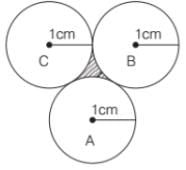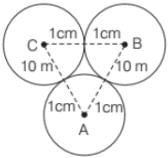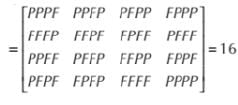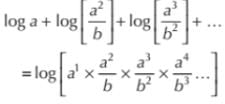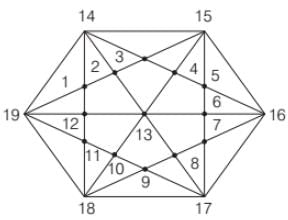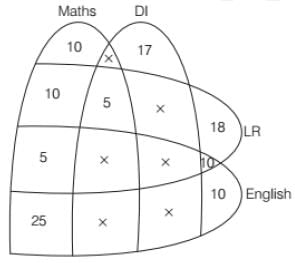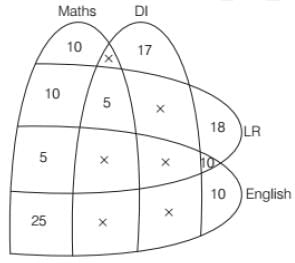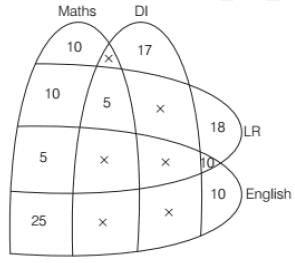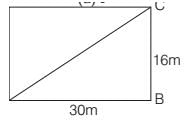Test: SNAP Quant 2019 - CAT MCQ
30 Questions MCQ Test - Test: SNAP Quant 2019
| 1 Crore+ students have signed up on EduRev. Have you? Download the App |
Length of two trains is 150 m each. When they are moving in opposite directions. They cross each other in their 20s and when they are moving in the same direction. Then the faster train passed the slower train in the 40s. Then find the speed of the faster train.
Brigadier Rastogi travels from A to Bat 40 km/h on a bike. He travels from B to C at 10 km/h on cycle. The distance from A to Bisequal to B to C. Then he travels from C to A via B at 24 km/h by auto-rickshaw. Find his average speed.
Rohan and Rahul are 144 km apart on point A and point B respectively. Rohan travels constantly at 8 km/h. Rahul travels 4 km in the first hour, 5 km in the second hour, 6 km in the third hour and so on. Find the point where they well meet.
Find the unit’s digit of (1!)1! + (2!)2! + (3!)3! + …….. + (100!)100!.
In how many ways can 10 books on mechanics and 8 books on quantum physics be placed in a row such that two books on quantum physics may not be together?
In an institute, an MBA Exam is conducted and a sectional cut off has been introduced into it. Any candidate appearing for the exam cannot qualify unless he clears the sectional cut off. If there are 4 sections in the paper, then what is the number of ways an applicant may fail in the exam.
In how many ways can letters of the word SOTICA be arranged such that vowels occupy odd positions?
Square, Circle, Hexagon and Octagon have equal perimeter. Which has the maximum area?
In how many ways can one wrap 3 Kitkat, 2 Fivestar and 3 Bar one. If at least one Kitkat has to be there in the gift pack and the gift pack has three chocolates.
The difference between compound and simple interest for a loan is 114 when invested for 2 yr. The rate of interest is 6% per annum. Find the loan amount.
In a regular hexagon field, ropes are tied to connect all vertices (diagonal and side). What is the number of intersection points of ropes?
In the given diagram, ∠ CAB = 60° and BC = a, AC = b, and AB = c.
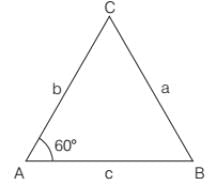
Then which of the following is correct?
In a closed wooden box, length = 20 cm breadth = 14 cm and height = 10 cm and thickness = 5 mm. If the weight of an empty box is 3.462 kg, then what is the weight of 1 cm 3 of wood (in gms)?
Find the number of zeros at the end of (5!)5! + (10!)10! + (50!)50! + (100!)100!
Gitesh is twice as good as Jitesh. Gitesh takes 30 days less than Jitesh to finish a task. How long will Gitesh and Jitesh take to complete the task together.
Mohan has a 200 L container. K L of milk is kept in the container. Mohan removes 6L milk and adds 6L water. He again replaces 6L of solution with water. Now milk and water are in the ratio 9: 16. What is the value of K?
Indian express travels at 60 km/h and halts. For fixed time every hour. Due to halts, the average speed becomes 50 km/h. Find the time of halt.
Directions: Read the given information carefully and answer the given question. In 2015, 100 aspirants appeared for an exam.
They had to answer four sections Maths, DI, LR and English.
The number of students who qualified in Maths = 55.
The number of students who qualified in LR= 38.
The number of students who qualified in (Maths + English) = 30.
The number of students who qualified in (LR + English) = 15.
The number of students who qualified in (Maths + LR) = 20.
The number of students who qualified in (Maths + LR + English) = 5.
The number of students who qualified in DI = 22.
The number of students who qualified in (DI + LR) = 5.
The number of students who qualified in (DI + Maths) = 5.
The number of students who qualified in (DI + Maths + LR) = 5.
The number of students who qualified in English = 50.
Those who qualified in English, could not qualify in the DI section.
Q. How many qualified at least two sections?
Directions: Read the given information carefully and answer the given question. In 2015, 100 aspirants appeared for an exam.
They had to answer four sections Maths, DI, LR and English.
The number of students who qualified in Maths = 55.
The number of students who qualified in LR= 38.
The number of students who qualified in (Maths + English) = 30.
The number of students who qualified in (LR + English) = 15.
The number of students who qualified in (Maths + LR) = 20.
The number of students who qualified in (Maths + LR + English) = 5.
The number of students who qualified in DI = 22.
The number of students who qualified in (DI + LR) = 5.
The number of students who qualified in (DI + Maths) = 5.
The number of students who qualified in (DI + Maths + LR) = 5.
The number of students who qualified in English = 50.
Those who qualified in English, could not qualify in the DI section.
Q. How many qualified in both Maths and LR, but not in any other section?
Directions: Read the given information carefully and answer the given question. In 2015, 100 aspirants appeared for an exam.
They had to answer four sections Maths, DI, LR and English.
The number of students who qualified in Maths = 55.
The number of students who qualified in LR= 38.
The number of students who qualified in (Maths + English) = 30.
The number of students who qualified in (LR + English) = 15.
The number of students who qualified in (Maths + LR) = 20.
The number of students who qualified in (Maths + LR + English) = 5.
The number of students who qualified in DI = 22.
The number of students who qualified in (DI + LR) = 5.
The number of students who qualified in (DI + Maths) = 5.
The number of students who qualified in (DI + Maths + LR) = 5.
The number of students who qualified in English = 50.
Those who qualified in English, could not qualify in the DI section.
Q. How many did not qualify any section?
Directions: Read the given information carefully and answer the given question. In 2015, 100 aspirants appeared for an exam.
They had to answer four sections Maths, DI, LR and English.
The number of students who qualified in Maths = 55.
The number of students who qualified in LR= 38.
The number of students who qualified in (Maths + English) = 30.
The number of students who qualified in (LR + English) = 15.
The number of students who qualified in (Maths + LR) = 20.
The number of students who qualified in (Maths + LR + English) = 5.
The number of students who qualified in DI = 22.
The number of students who qualified in (DI + LR) = 5.
The number of students who qualified in (DI + Maths) = 5.
The number of students who qualified in (DI + Maths + LR) = 5.
The number of students who qualified in English = 50.
Those who qualified in English, could not qualify in the DI section.
Q. How many qualified only DI sections?
Directions:
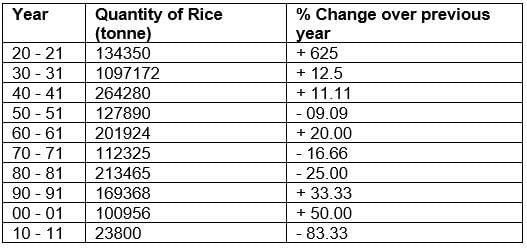
Q. What is the approximate production of rice in the year 1949-50?
Directions:
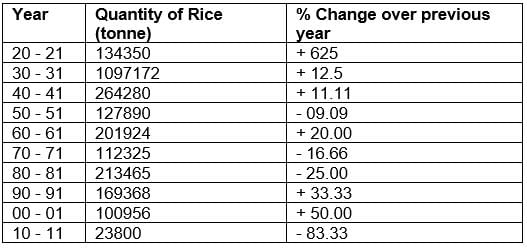
Q. What is the difference in the production of rice in 1969-70 and 1979-80?
Directions:
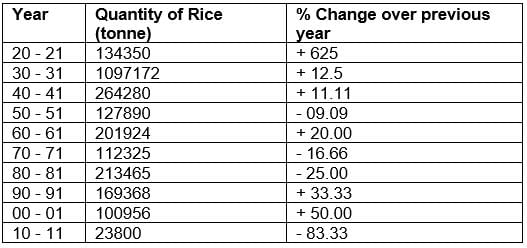
Q. What is the approximate production in 1959-60?
What is the sum of integers from 113 to 113113, which are divisible by 7?
Robot is 4 m in length and placed at a corner of a 16 m × 30 m field. The robot is facing a diagonally opposite corner and reaches the diagonally opposite corner in 15 s. What is the speed (in m/s) of a robot?





